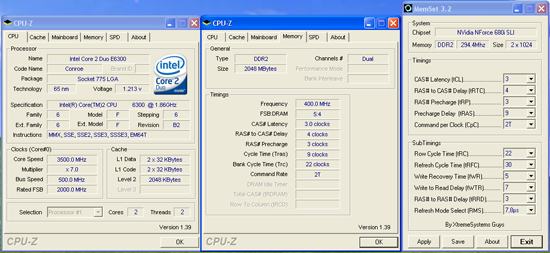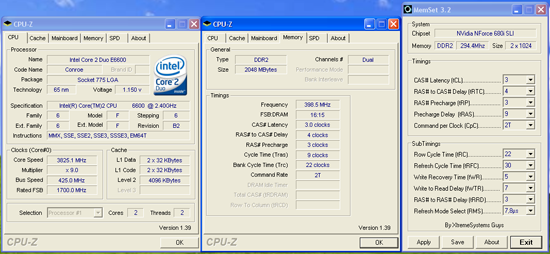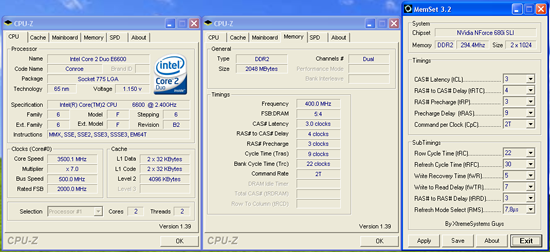EVGA 680i LT SLI: NVIDIA's 680i Cost Reduced
by Gary Key on March 28, 2007 4:00 AM EST- Posted in
- CPUs
Overclocking - E6300
We were easily able to reach a final benchmark stable setting of 7x500 FSB resulting in a clock speed of 3500MHz. We were able to run our OCZ Flex PC2-9200 and Corsair PC2-8888 at the reported timings with a 1T Command Rate enabled with 2.30V. However, when overclocking we had to run our standard OCZ Flex PC2-6400 at 2T command rates due to the next voltage step being 2.30V, a setting that is not recommended for the ProMOS chips (2.250V is our recommended limit for 24/7 operation). Vdroop was very acceptable on this board during overclocking with an average drop of .02 ~.03V during load testing with our E6300.
Testing with our new OCZ Flex PC2-6400 CAS3 (standard memory installed) and G.Skill F2-6400CL4D-2GBHK modules based on the ProMOS IC chips resulted in great success on this board. The OCZ Flex PC2-6400 was able to run at DDR2-800 speeds with timings at 3-4-3-9 2T at 2.15V and the G.Skill F2-6400CL4D at 4-3-3-8 2T at 2.15V on our other NVIDIA boards but we had to use the 2.20V setting. The remaining memory timings are set to Auto as is standard in our testing and manually setting these timings resulted in minimal performance gains. We did notice in 4GB testing that we had to change our OCZ Flex PC2-6400 CAS3 memory timings to 3-4-4-12 2T at 2.20V for stable 24/7 operation in a variety of applications.
Overclocking - E6600
After trying numerous settings and voltages we finally found a benchmark stable setting of 9x425 FSB resulting in a clock speed of 3825MHz. We did find the typical FSB hole around 416FSB that continued until 422FSB. We were able to post and complete benchmark testing at 432FSB but could not pass dual Prime95 at that setting. Vdroop was acceptable during overclocking with an average drop of .03 ~.04V during load testing with our E6600. We generally found that without decent airflow around the CPU and memory locations that our maximum FSB was near 410 MHz with this configuration.
We dropped the multiplier on our E6600 to seven and were able to reach 500 FSB. We entered XP at 7x518 but the board was not stable due to a lack of higher FSB/SPP/MCP voltages. At first we thought the board was locked at 500FSB but once again we found FSB holes but this time they ranged from 502 to 516. We jokingly started to refer to this board as Swiss cheese during testing as everywhere we turned there was another FSB hole. If NVIDIA had offered VTT and GTL Ref Voltage options in the BIOS we are sure several of our holes could have been solved but we were still able to work around most of them.
In our overclock testing we were able to extract an 1133MHz memory speed at 5-5-5-15 2T timings with our OCZ Flex PC2-6400. This is the highest speed we have reached with this memory and at synced speeds we were able to reach DDR2-850 with timings at 3-4-4-9 2T on 2.20V. We dropped in our OCZ Flex PC2-9200 and Corsair PC2-9136 modules with both being able to reach DDR2-1275 with 5-5-4-12 2T timings at 2.30V. Memory performance and stability was excellent once the board was dialed in.
| EVGA 680i LT SLI Dual Core Overclocking Testbed |
|
| Processor: | Intel Core 2 Duo E6300 Dual Core, 1.86GHz, 2MB Unified Cache 1066FSB, 7x Multiplier |
| CPU Voltage: | 1.4500V (default 1.3250V) |
| NB Voltage: | 1.40V |
| FSB Voltage: | 1.40V |
| Cooling: | Tuniq 120 Air Cooling |
| Power Supply: | OCZ ProXStream 1000W |
| Memory: | OCZ Flex XLC PC2-6400 (2x1GB) (ProMOS Memory Chips) |
| Video Cards: | 1 x MSI 8800GTX |
| Hard Drive: | Western Digital 150GB 10,000RPM SATA 16MB Buffer |
| Case: | Cooler Master CM Stacker 830 |
| Maximum OC: | 500x7 (3-4-3-9 2T, 800MHz, 2.20V), CPU 1.4500V 3500MHz (+88% FSB/CPU) |
| . | |
 |
| Click to enlarge |
We were easily able to reach a final benchmark stable setting of 7x500 FSB resulting in a clock speed of 3500MHz. We were able to run our OCZ Flex PC2-9200 and Corsair PC2-8888 at the reported timings with a 1T Command Rate enabled with 2.30V. However, when overclocking we had to run our standard OCZ Flex PC2-6400 at 2T command rates due to the next voltage step being 2.30V, a setting that is not recommended for the ProMOS chips (2.250V is our recommended limit for 24/7 operation). Vdroop was very acceptable on this board during overclocking with an average drop of .02 ~.03V during load testing with our E6300.
Testing with our new OCZ Flex PC2-6400 CAS3 (standard memory installed) and G.Skill F2-6400CL4D-2GBHK modules based on the ProMOS IC chips resulted in great success on this board. The OCZ Flex PC2-6400 was able to run at DDR2-800 speeds with timings at 3-4-3-9 2T at 2.15V and the G.Skill F2-6400CL4D at 4-3-3-8 2T at 2.15V on our other NVIDIA boards but we had to use the 2.20V setting. The remaining memory timings are set to Auto as is standard in our testing and manually setting these timings resulted in minimal performance gains. We did notice in 4GB testing that we had to change our OCZ Flex PC2-6400 CAS3 memory timings to 3-4-4-12 2T at 2.20V for stable 24/7 operation in a variety of applications.
Overclocking - E6600
| EVGA 680i LT SLI Dual Core Overclocking Testbed |
|
| Processor: | Intel Core 2 Duo E6600 Dual Core, 2.4GHz, 4MB Unified Cache 1066FSB, 9x Multiplier |
| CPU Voltage: | 1.4750V / 1.4500 (default 1.3250V) |
| NB Voltage: | 1.40V |
| FSB Voltage: | 1.40V |
| Cooling: | Tuniq 120 Air Cooling |
| Power Supply: | OCZ ProXStream 1000W |
| Memory: | OCZ Flex XLC PC2-6400 (2x1GB) (ProMOS Memory Chips) |
| Video Cards: | 1 x MSI 8800GTX |
| Hard Drive: | Western Digital 150GB 10,000RPM SATA 16MB Buffer |
| Case: | Cooler Master CM Stacker 830 |
| Maximum CPU OC: | 425x9 (3-4-3-9 2T, 799MHz, 2.20V), CPU 1.4750V 3825MHz (+59%) |
| Maximum FSB OC: | 500x7 (3-4-3-9 2T, 800MHz, 2.20V), CPU 1.4500V 3500MHz (+88% FSB) |
| . | |
 |
| Click to enlarge |
After trying numerous settings and voltages we finally found a benchmark stable setting of 9x425 FSB resulting in a clock speed of 3825MHz. We did find the typical FSB hole around 416FSB that continued until 422FSB. We were able to post and complete benchmark testing at 432FSB but could not pass dual Prime95 at that setting. Vdroop was acceptable during overclocking with an average drop of .03 ~.04V during load testing with our E6600. We generally found that without decent airflow around the CPU and memory locations that our maximum FSB was near 410 MHz with this configuration.
 |
| Click to enlarge |
We dropped the multiplier on our E6600 to seven and were able to reach 500 FSB. We entered XP at 7x518 but the board was not stable due to a lack of higher FSB/SPP/MCP voltages. At first we thought the board was locked at 500FSB but once again we found FSB holes but this time they ranged from 502 to 516. We jokingly started to refer to this board as Swiss cheese during testing as everywhere we turned there was another FSB hole. If NVIDIA had offered VTT and GTL Ref Voltage options in the BIOS we are sure several of our holes could have been solved but we were still able to work around most of them.
In our overclock testing we were able to extract an 1133MHz memory speed at 5-5-5-15 2T timings with our OCZ Flex PC2-6400. This is the highest speed we have reached with this memory and at synced speeds we were able to reach DDR2-850 with timings at 3-4-4-9 2T on 2.20V. We dropped in our OCZ Flex PC2-9200 and Corsair PC2-9136 modules with both being able to reach DDR2-1275 with 5-5-4-12 2T timings at 2.30V. Memory performance and stability was excellent once the board was dialed in.










16 Comments
View All Comments
MrWizard6600 - Thursday, March 29, 2007 - link
dont know the full details, but the newest P26 Bios from EVGA Removed LinkBoost support“LinkBoost was removed from nForce 680i SLI because it did not show significant demonstrable benefit in games. We had hoped newer games would take advantage of this additional bandwidth but this has not been the case. Please note that future BIOS upgrades will only remove the automatic overclocking component of LinkBoost. Users can still manually overclock the PCI-Express and HyperTransport buses in the BIOS."
SniperWulf - Wednesday, March 28, 2007 - link
Any chance I can get that registry key that you deleted after the nv4_disp crash?yacoub - Wednesday, March 28, 2007 - link
It's time to start recommending Supreme Commander to be the RTS game test choice. Now that there's a new RTS game that can crush systems (SupCom) the way FEAR did for FPS games for the last couple years, a game that makes use of multiple cores at that, we should start to see it used in the suite of games in future motherboard, cpu, and gpu tests. Perhaps Anandtech have already started planning for this?yyrkoon - Wednesday, March 28, 2007 - link
Well, it is not an RTS game, but one I play frequently should also be used to test gaming rigs in my humble opinon. Titan Quest (Immortal Throne if deemed nessisary).My gaming Rig is not top of the line, but it is no slouch, and this game constantly drags in areas that are low light areas, or are outside, and night time. Anyhow, and game that brings my opteron 1210 / ABIT NF-M2 nView / 2 GB DDR2 6400 memory, eVGA 7600GT KO to a crawl, SHOULD be used as a benchmark, at least once in a while. F.E.A.R does not lag like this game does on my system . . .
Stele - Wednesday, March 28, 2007 - link
I agree to an extent, as the current test suite's figures are starting to show their age a wee bit... 100+ FPS, as Quake ended up with newer CPUs/GPUs. Having said that, Anandtech was probably trying to ensure consistency in its tests, so that at the very least, past test results for other products can always be quite easily compared over time. Perhaps in the near future we might see it yet! :)JarredWalton - Wednesday, March 28, 2007 - link
I believe Gary is looking at benching with Supreme Commander. That's one of the games that will be added in future reviews, as far as I know.yacoub - Wednesday, March 28, 2007 - link
Awesome, glad to hear that! One can see the benefit to maintaining benchmark titles for as long as possible to allow the greatest comparison back to past reviews. On the up side, SupCom looks to easily task systems well into the future (much like FEAR has thus far since its release) and would be an excellent choice for the RTS benchmark game. :)yyrkoon - Wednesday, March 28, 2007 - link
Firstly, I have to get this out. It is a completely LAME excuse for nVidia, eVGA, Foxconn, or whomever, to 'claim' the reason this board does not have passive cooling (OTES or equivelent), is to help cut costs. 20 bux less, and they rip out passive cooling ? Lame. Take ABITs NF-M2 nView $85usd , including passive cooling, and moderate other features. Granted, it is based on the NF4 chipset, but who cares, it has passive cooling, and loads of other features for the price.I have to agree somewhat with the first poster, this board is dead, before it even reaches market. Crippled features, missing other features, all for to save $20-$50 usd. Sorry nVidia, and whomever else, but you have not only completely wasted your time, but ours as well, for having to read a review on such a shitty product.
yacoub - Wednesday, March 28, 2007 - link
very much agree. the passive cooling is (and should be) an integral feature of current generation motherboards. there's no reason ANY motherboard released today should require active northbridge (or southbridge) chipset cooling (unless you're overclocking, obviously).yyrkoon - Wednesday, March 28, 2007 - link
One thing I did keep wondering the whole time I was reading the article, and you were mentioning how the BIOS was basically a crippled version of the full blown i680 SLI version was: 'I wonder how soon someone would mod a BIOS version based on the i680 SLI chipset BIOS, to add removed 'features' such as certain voltage settings, etc.'Also, Jarred, or whomever else would like to answer, how hot does the PWM section of this motherboard run ? Seems lately, dual core on up motherboards tend to run hot in the PWM.